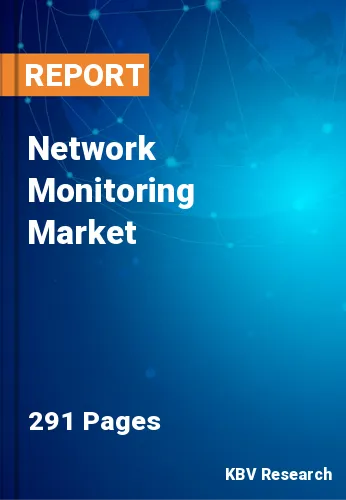The Global Network Monitoring Market size is expected to reach $3.2 billion by 2028, rising at a market growth of 6.5% CAGR during the forecast period.
Network monitoring is a modern-day technology that is used to track and monitor computer networks in case of data loss or theft. In the event of data loss and theft, it informs or notifies the network administrator. Continuous network monitoring is crucial since malfunctioning devices have an impact on network performance. These systems continuously observe vast amounts of data, making it feasible to filter data to identify any irregularities by using network monitoring tools. As a result, these technologies are used by businesses, cloud services, and telecommunications.
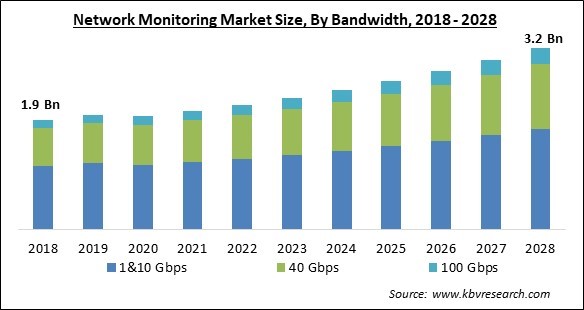
The term network monitoring is now used often in the IT sector. All networking components, including routers, firewalls, switches, servers, and virtual machines (VMs), are regularly reviewed to maintain and maximize their availability while being monitored for faults and performance. The proactive nature of network monitoring is a crucial component. Proactively locating performance problems and constraints aids in early problem detection.
Effective proactive network monitoring can stop network failures or downtime. The increased usage of this technology by businesses, telecommunications companies, and cloud service providers to control network traffic address growing data security concerns, and adhere to legal requirements is boosting the market for network monitoring.
Network performance is significantly impacted by malfunctioning network hardware. Early discovery of this can prevent it, Due to this, network device monitoring is very crucial. Identifying the devices as well as the relevant performance indicators to be examined is the first step in efficient network monitoring. Choosing the monitoring interval is the second step. While servers, routers, and switches carry out business-essential functions but also have different parameters that may be selectively monitored, PCs and printers are not essential and do not need frequent monitoring.
The market for network monitoring has been impacted by the outbreak and spread of COVID-19. The COVID-19 pandemic had an effect on international operations in numerous industries and geographical locations. Since the businesses encountered limited supply or restricted demand that generated substantive repercussions, the virus's negative effects spread more quickly in areas where consumers, manufacturers, or suppliers, conduct business. This is a result of manpower limitations, constrained manufacturing, postponed purchases, supply-chain interruptions, and prohibitions on cross-border trade, which caused delays in the fulfillment of shipments of raw materials and components.
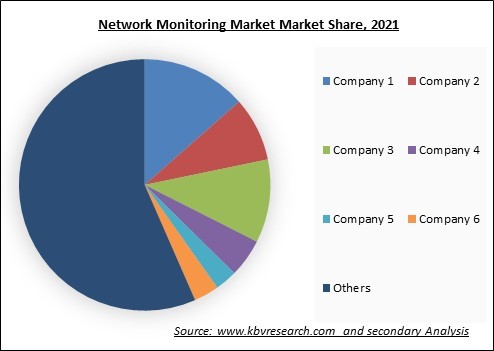
The leading players in the market are competing with diverse innovative offerings to remain competitive in the market. The below illustration shows the percentage of revenue shared by some of the leading companies in the market. The leading players of the market are adopting various strategies in order to cater demand coming from the different industries. The key developmental strategies in the market are Product Launches and Product Expansions.
Failure of network equipment can result in increased downtime, lost productivity, and even security risks. High CPU or network utilization can cause activities to grind to an unpleasant halt, while hardware problems and failures can put the entire infrastructure to a standstill. Through network monitoring, these issues can be quickly located and fixed. By reducing downtime, network monitoring lowers costs for the business. By automatically adding mapping network topology, and new devices, and exposing malicious activity or potential breaches, many network monitoring tools also bring value.
Bring-Your-Own-Device, or BYOD is a trend where employees are given personal mobile devices along with software to use for both personal and professional purposes. The increased adoption of BYOD by businesses has led to a significant increase in the penetration of mobile devices. Large amounts of data are saved on, transmitted to and from mobile devices due to the diversity of services, applications, and functionalities accessible. Most of the information kept on mobile devices is sensitive, including credit card numbers, passwords, and usernames. Organizations are putting into place efficient monitoring and analytics solutions as a result of this rise in mobile device use.
One of the major factors that are constraining the growth of the market is the high cost related to network monitoring. Businesses must improve their networks to provide bandwidth and new capabilities as more corporate processes move online. Networks increasingly need to support various business services, like video conferencing and telephony, which need more network bandwidth in addition to handling traditional IT applications. Multicasting protocols must also be added for multimedia applications, autoconfiguration protocols must be added for new endpoint devices, and IP virtualization features must be added for the deployment of new services to shared network infrastructure.
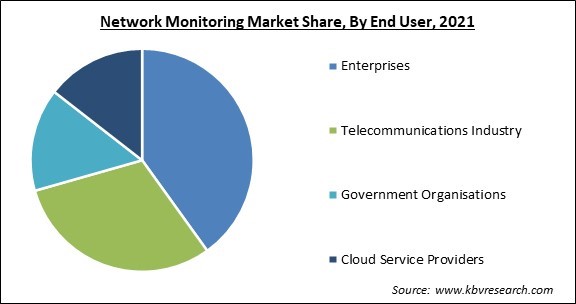
Based on offerings, the network monitoring market is segmented into Equipment and Software & Services. In 2021, the equipment segment garnered a significant revenue share of the network monitoring market. The increasing growth of the segment is attributed to the rising necessity of equipment, such as storage devices, in order to deploy network monitoring solutions. The health, availability, and efficiency of networks, which comprise storage devices, networking hardware, interfaces, virtual environments, and other crucial components, are continuously tracked, analyzed, and reported using network monitoring software.
On the basis of bandwidth, the network monitoring market is divided into 1&10 Gbps, 40 Gbps and 100 Gbps. In 2021, the 100 Gbps segment acquired a substantial revenue share of the network monitoring market. The rapidly rising growth of the segment is owing to the increase in data volumes that are being generated over these networks. Almost every process in every sector is turning digital nowadays, due to which, massive amounts of corporate, personal, and public data is being generated. This factor is aiding in the rising growth of the segment.
By technology, the network monitoring market is classified into Ethernet, Fiber Optic and InfiniBand. In 2021, the InfiniBand segment witnessed a substantial revenue share of the network monitoring market. To lower networking equipment prices and satisfy the demands for high bandwidth, low latency computation, storage, and administration via a single fabric, InfiniBand-based network monitoring systems are employed.
Based on end-user, the network monitoring market is fragmented into Enterprises, Telecommunication Industry, Government Organizations and Cloud Service Providers. In 2021, the telecommunication industry segment registered a significant revenue share of the network monitoring market. One of the main factors propelling the growth of the network monitoring market is the significant growth of the telecommunications sector. The demand for comprehensive visibility of network infrastructure is fueling the expansion of the industry.
| Report Attribute | Details |
|---|---|
| Market size value in 2021 | USD 2.1 Billion |
| Market size forecast in 2028 | USD 3.2 Billion |
| Base Year | 2021 |
| Historical Period | 2018 to 2020 |
| Forecast Period | 2022 to 2028 |
| Revenue Growth Rate | CAGR of 6.5% from 2022 to 2028 |
| Number of Pages | 291 |
| Number of Tables | 523 |
| Report coverage | Market Trends, Revenue Estimation and Forecast, Market Share Analysis, Segmentation Analysis, Regional and Country Breakdown, Competitive Landscape, Companies Strategic Developments, Company Profiling |
| Segments covered | Bandwidth, Technology, Offerings, End User, Region |
| Country scope | US, Canada, Mexico, Germany, UK, France, Russia, Spain, Italy, China, Japan, India, South Korea, Singapore, Malaysia, Brazil, Argentina, UAE, Saudi Arabia, South Africa, Nigeria |
| Growth Drivers |
|
| Restraints |
|
Region-wise, the network monitoring market is analyzed across North America, Europe, Asia Pacific and LAMEA. In 2021, North America held the largest revenue share of the network monitoring market. The growth of the regional market is attributed to the growing need for more IT capacity as well as the increasing use of new data center technologies. Since many businesses are likely to choose cloud services rather than incur the upfront costs of constructing new data centers for business continuity, the industry in the US is predicted to gain more traction.
Free Valuable Insights: Global Network Monitoring Market size to reach USD 3.2 Billion by 2028
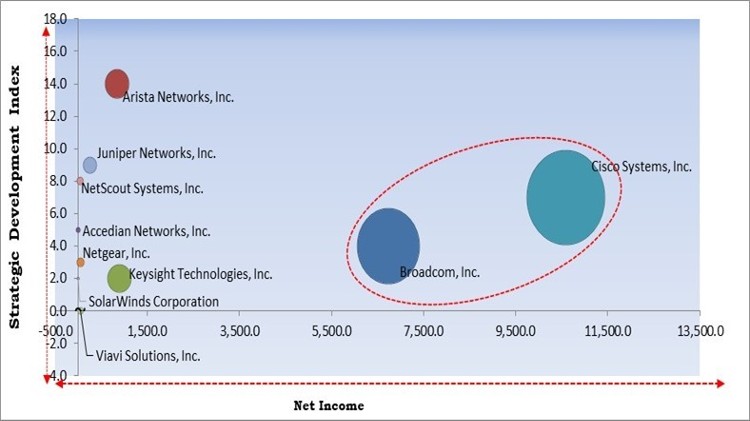
The major strategies followed by the market participants are Product Launches. Based on the Analysis presented in the Cardinal matrix; Broadcom, Inc. and Cisco Systems, Inc. are the forerunners in the Network Monitoring Market. Companies such as Keysight Technologies, Inc., Netgear, Inc. and Juniper Networks, Inc. are some of the key innovators in Network Monitoring Market.
The market research report covers the analysis of key stake holders of the market. Key companies profiled in the report include Cisco Systems, Inc., SolarWinds Corporation, Juniper Networks, Inc., Arista Networks, Inc., NetScout Systems, Inc., Broadcom, Inc., Netgear, Inc., Keysight Technologies, Inc., Viavi Solutions, Inc., and Accedian Networks, Inc.
By Bandwidth
By End User
By Technology
By Offerings
By Geography
The global Network Monitoring Market size is expected to reach $3.2 billion by 2028.
Increased Resiliency Of The Solution are driving the market in coming years, however, High Cost Of Deployment And Further Processes restraints the growth of the market.
Cisco Systems, Inc., SolarWinds Corporation, Juniper Networks, Inc., Arista Networks, Inc., NetScout Systems, Inc., Broadcom, Inc., Netgear, Inc., Keysight Technologies, Inc., Viavi Solutions, Inc., and Accedian Networks, Inc.
The Enterprises segment acquired maximum revenue share in the Global Network Monitoring Market by End User in 2021 thereby, achieving a market value of $1.1 billion by 2028.
The Software & Services segment is leading the Global Network Monitoring Market by Offerings in 2021, thereby, achieving a market value of $2 Billion by 2028.
The North America market dominated the Global Network Monitoring Market by Region in 2021, and would continue to be a dominant market till 2028; thereby, achieving a market value of $1.1 billion by 2028.
Our team of dedicated experts can provide you with attractive expansion opportunities for your business.
